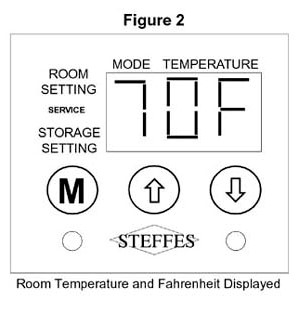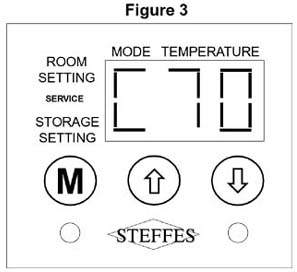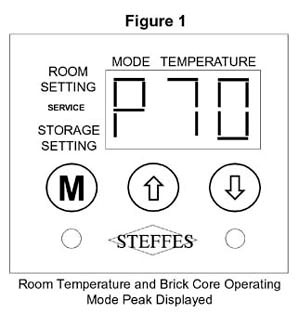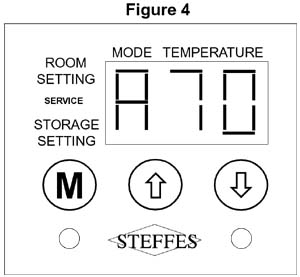Typically, the face plate of the control panel will continuously display current room temperature. It will also display a "C" for charge, "P" for peak, or "A" for anticipated peak to indicate the current brick core operating mode (See Figure 1). The face plate can be set so these brick core charging modes are not displayed; but, rather, an "F" for Fahrenheit or "C" for Celsius is displayed after the room temperature (See Figure 2.)

NOTE: These options can be preset to owner preference during the installation procedure when the heater operational functions are being set. The installing electrical contractor or power company personnel will have more information on how to change these functions in the heater.
Charge Mode (Off-Peak): See Figure 3

-
MODE digit displays a "C".
-
TEMPERATURE digits display current room temperature.
-
During this mode, if the temperature of the brick core is insufficient (based on the manual charge setting or the automatic charge control outdoor temperature information), the heating elements will be on. Heat will be stored in the bricks to maintain the appropriate charge level. Once the appropriate brick core charge level is reached, the heating elements will automatically turn off.
-
The blower turns on when the room thermostat calls for heat and extracts heat from the brick core to maintain a constant, comfortable room temperature.
-
If the room thermostat calls for heat during a time when there is no heat stored in the brick core, the blower and heating elements will come on and begin releasing heat to the area until the heat call has been satisfied.
Peak Mode (On-Peak): See Figure 1

-
MODE digit displays a "P".
-
TEMPERATURE digits display actual room temperature.
-
During this mode, the heater is not allowed to store heat in the bricks. The heating elements will remain off for the duration of the on-peak period. (Exception: If the utility company permits the use of the freeze protection and/or comfort override options, some element operation may occur. See below.)
-
The blower turns on when the room thermostat calls for heat and extracts heat from the brick core to maintain a constant, comfortable room temperature.
|
Comfort Override (power company permitting) |
|---|
|
This feature is used to achieve room comfort in the area where the heater is located if the stored heat in the brick core has been depleted. If the power company permits the use of this feature, it will allow the heating elements to come on during a peak mode. This occurs only if the room temperature falls a preset number of degrees below the room temperature set point and the stored heat in the brick core has been depleted. |
|
Freeze Protection (power company permitting) |
|---|
|
This feature is used to maintain a temperature above freezing in the area where the heater is located. If the power company permits the use of this feature, it will allow the heating elements to come on during a peak mode. This occurs only if room temperature falls below the freeze protection temperature set point as programmed in the heater. |
NOTE: Freeze protection and peak override options may not be available in your area. Please consult your power company if you are unsure of whether these options are available to you.
3. Anticipated Peak (Pre-Peak) Mode: See Figure 4

This mode is used only in specialized installations. You may not have this option enabled on your heating unit.
This mode of operation is used in situations where the power company sends a signal to the equipment prior to the possibility of a control (on-peak) period. Once the signal is received, the room heating unit will charge to a level needed to satisfy the heating requirements of the area during the control period.
-
MODE digit displays an "A".
-
TEMPERATURE digits display actual room temperature.
-
During this mode, the heater is allowed to store heat in the brick core. If the brick core charge level is insufficient (based on the manual charge setting or the automatic charge control outdoor temperature information), the heating elements will be on. Heat will be stored in the bricks to maintain the appropriate charge level. Once the appropriate brick core charge level is reached, the heating elements will automatically turn off.
-
The heater can be set so that the blower comes on as the room thermostat calls for heat, or it can be set so that it cannot come on at all during an anticipated peak period. The heater can also be set so that there is limited blower operation during this time. Under some situations, limiting the amount of blower operation, or not allowing it to come on at all, may be necessary to ensure that the room heating unit will have an adequate amount of heat stored in the bricks for an upcoming peak control period.